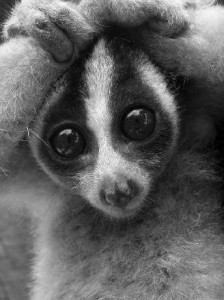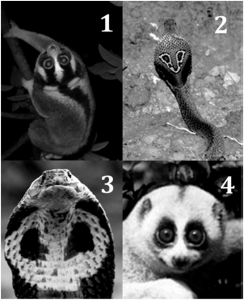
In a new review article published today in Journal of Venomous Animals and Toxins including Tropical Diseases (JVATiTD), Anna Nekaris and colleagues review the remarkable biochemistry and etiology of slow loris venom.

The slow loris (Nycticebus spp.) is the world’s only venomous primate, just one of seven venomous species of mammal.
From a defensive posture, with raised arms, it can produce a potent venom by combining fluid from its brachial gland with saliva. The toxic mixture is either applied to the top of the head to ward off attackers or kept in the mouth to administer with a sharp and painful bite. Slow loris venom has been known to cause anaphylaxis and even death in small animals and humans.
Although folklore in Southeast Asia has long ascribed deadly or even black magic properties to the slow loris and its blood or venom, the first scientific reports of Nycticebus venom only emerged in the mid-1990s.
Chemical structure of slow loris venom
The authors review a series of experiments to shed light on the biochemistry of slow loris venom. High performance liquid chromatography was used to identify the various components of the loris’ brachial gland secretions. The technique identified a protein with strong genetic similarity to the cat allergen Fe1-d1.
Fe1-d1 is used by cats as a species recognition molecule. If the brachial secretions in slow loris venom can be used by the animals in this way, it seems likely that the venom may have utility beyond that of a direct toxic defense.
Function of slow loris venom
There is a related hypothesis that slow loris venom was initially used for species recognition – not unlike Fe1-d1 in cats – to stake territorial claims or to act as a warning signal to other lorises, and eventually evolved into a potent direct venom.
Observations in the lab and in field studies suggest that the slow loris uses its venom to directly repel predators, especially those reliant on smell (e.g. cats and sun bears). Anointment of its fur with venom also provides the loris with a first line chemical defense against parasites.
Nekaris and colleagues also review evidence for venom being used by slow lorises against their conspecifics. Intersexual competition and territorial skirmishes occur frequently between lorises, especially in breeding season, and these fights are often brought to a close by venom-laden bites. In this context, anointment of fur on the loris’ head with venom is a measure to protect the most vulnerable part of their body during fights.
Why did the venom evolve?

One particularly compelling hypothesis for slow loris venom etiology is explored in depth by the authors: the theory that slow loris venom may have evolved to mimic cobras.
The facial markings of various slow loris species bear a strong resemblance to the dorsal patterns of the spectacled cobra (Naja naja). Other serpentine features have been observed in the slow loris, from its hiss-like vocalizations when threatened to the graceful movement conferred to the loris by its additional vertebrae.
Nekaris and colleagues suggest that these features could reflect a form of Müllerian mimicry in the slow loris. The spectacled cobra would be unwanted and noxious prey for a number of predators. For the predator looking to identify its prey, the slow loris’ resemblance to these cobras would bring uncertainty and risk to any attack.
Savannah-like conditions brought on by climatic events in Southeast Asia several million years ago would have exposed the slow loris to a number of new predators in common with the spectacled cobra. This may have triggered a selection event in the species, towards cobra mimicry.
Endangered status
The Javan slow loris (Nycticebus javanicus) has been listed as endangered, with a suspected decline of at least 50% over the last three generations. Slow lorises have been the target of capture for a burgeoning illegal pet trade, fuelled in part by their misrepresentation in viral video content.
Thankfully, awareness of the slow loris’ endangered status and illegal trade seems to be increasing – even amid the quagmire of Youtube comments – as the result of educational efforts by conservation scientists and outreach groups.
About the authors
- Anna Nekaris is Professor in Anthropology and Primate Conservation at Oxford Brookes University, and the director of the Little Fireface Project, named after the Sudanese word for the slow loris. She is also active on Twitter and has featured in numerous interviews and discussion panels on the slow loris.
- Dr Richard Moore is research director of International Animal Rescue’s slow loris rescue centre in Indonesia.
- Johanna Rode conducted her PhD research on the ecological function of slow loris venom in Java.
- Dr Brian Fry is group leader of the Venomics Laboratory at the School of Biological Sciences, University of Queensland, and a world expert in all manner of venomous animals (from spiders and snakes to jellyfish and sharks).
Article information
Mad, bad and dangerous to know: the biochemistry, ecology and evolution of slow loris venom
Anne-Isola Nekaris, Richard S Moore, Johanna Rode and Bryan G Fry
Journal of Venomous Animals and Toxins including Tropical Diseases 2013, 19:21
doi:10.1186/1678-9199-19-21
full text
Matthew Landau
Latest posts by Matthew Landau (see all)
- March biology highlights: octopuses, heavy metal, and pocket-sized DNA sequencing - 10th April 2015
- From farm to plate, make food safe! - 7th April 2015
- Dried up! The effects of 2014 on Western US Lake Ecosystems - 13th November 2014
Comments